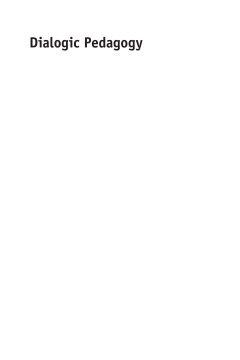
Additional Information
Book Details
Abstract
This book provides a wide-ranging and in-depth theoretical perspective on dialogue in teaching. It explores the philosophy of dialogism as a social theory of language and explains its importance in teaching and learning. Departing from the more traditional teacher-led mode of teacher–student communication, the dialogic approach is more egalitarian and focuses on the discourse exchange between the parties. Authors explore connections between dialogic pedagogy and sociocultural learning theory, and argue that dialogic interaction between teacher and learners is vital if instruction is to lead to cognitive development. The book also presents prosody as a critical resource for understanding between teachers and students, and includes some of the first empirical studies of speech prosody in classroom discourse.
David Skidmore is Senior Lecturer in Education at the University of Bath, UK. He has worked in the field for over 20 years and is a member of the editorial board of Language and Education. His research interests include pedagogy, dialogue, inclusive education and prosody.
Kyoko Murakami is Associate Professor in the Department of Psychology at the University of Copenhagen, Denmark. Her research interests include social remembering, discursive psychology, cultural psychology, cultural historical activity theory, dialogic pedagogy and social and community psychology.
Drawing on a wide range of original sources, the contributing authors to this book provide a very informative and scholarly review of the theoretical foundations of dialogical pedagogy and methods for analysing classroom interaction.
Skidmore and Muramaki’s edited volume is an interesting work on the necessity for teachers to move towards more dialogical pedagogies, which allow for a redistribution of the shared responsibilities within institutional learning situations (...) the theories reviewed, the data analysed and the practices presented, will certainly appeal to| scholars, curriculum developers, language teaching practitioners, teachers’ educators and pre-service language teachers.
Jose Ignacio Aguilar Río, Sorbonne Nouvelle-Paris 3 University, France
If you’re looking for evidence of the importance of talk in student learning then this is the book for you. Drawing on a range of theoretical and empirical sources, it pays close attention to the development of a dialogic pedagogy in teacher-student and student-to-student interactions. Most importantly it reminds us of the importance of prosody, or tone of voice, to the achievement of shared understanding in teacher-student and peer-to-peer interaction.
This book puts language as experienced dialogical activity at the center of education. The interplay of improvisation and careful structuring allowing for the openness students and teachers need is beautifully shown. This book is a gift for all scholars and practitioners seeking an alternative approach to learning, development and language itself.
Table of Contents
| Section Title | Page | Action | Price |
|---|---|---|---|
| Contents | v | ||
| Contributors | ix | ||
| 1 Dialogic Pedagogy: An Introduction | 1 | ||
| 2 Dialogism and Education | 17 | ||
| 3 Vygotsky and Dialogic Pedagogy | 48 | ||
| 4 The Conceptions of ‘Dialogue’ Offered by Bohm and Buber: A Critical Review | 68 | ||
| 5 Classroom Discourse: A Survey of Research | 83 | ||
| 6 Pedagogy and Dialogue | 98 | ||
| 7 The Small Group Writing Conference as a Dialogic Model of Feedback | 111 | ||
| 8 Giving Learners a Voice: A Study of the Dialogic ‘Quality’ of Three Episodes of Teacher–Learner Talk-in-interaction in a Language Classroom | 135 | ||
| 9 Authoritative Versus Internally Persuasive Discourse | 153 | ||
| 10 Once More With Feeling: Utterance and Social Structure | 170 | ||
| 11 How Prosody Marks Shifts in Footing in Classroom Discourse | 186 | ||
| 12 Prosodic Chopping: A Pedagogic Tool to Signal Shifts in Academic Task Structure | 203 | ||
| 13 Claiming Our Own Space: Polyphony in Teacher–Student Dialogue | 220 | ||
| Appendix: Conversation Analysis Conventions Used for Data Transcription | 239 | ||
| Index | 240 |
